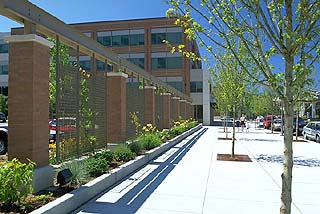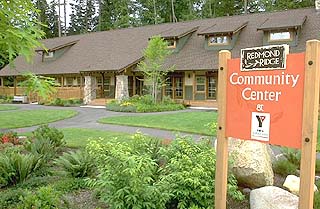
Surveys
DJC.COM
April 10, 2003
Landscape architects adapt to changing world
Weisman Design Group

Photos courtesy of LandImage AT&T headquarters in Redmond was designed with security in mind. |
The world changes, and so does the design world. Landscape architecture firms are in a position to take the lead in some of those changes, adapting to new realities even as their professional understanding of natural systems and site planning becomes more and more important.
The economic downturn and cataclysmic events of the past two years have changed society’s needs, perceptions and desires. And they have given us another chance to evolve. In a time of tough choices, here are some themes that now serve as guides for a successful practice.
Sustainability. Environmental responsibility is well and good when designing a vacation home for an enlightened and wealthy client, or creating an environmental center for a foundation with a healthy endowment. A more elusive goal is selling sustainability to the spec office developer or tract home builder.
Public awareness has grown greatly in the last decade, but it still has a long way to go. We strive to provide real, economic gains from sustainable building strategies. Projects that efficiently and responsibly use resources can be as competitive as those that ignore sustainable solutions.
The value of responsible use of resources can be magnified greatly when dealing with the large-scale urban-style projects which are becoming the centers of growth in the region — and a growing portion of our work.
From a landscape perspective, the use of sophisticated irrigation controls and drought-tolerant materials are obvious methods of resource conservation. Others include construction waste management, re-use of on-site materials and life-cycle planning. Our challenge is to educate our clients about evolving models of sustainability while meeting the demands of the market.

Redmond Ridge Community Center and grounds hark back to the past. |
Efficiency. The old real estate investor’s maxim “Buy land, they’re not making any more of it” might be updated. “Plan well!” applies to land development as never before.
Poorly planned development that squanders our limited land resource is no longer tolerated by society, and it’s becoming increasingly clear that it’s no longer economically viable.
Although intensive space utilization drives many of our current projects, a balance of program and site is still achievable. Our work at Bush School exhibits this evolution from inefficient land development to intensive and highly programmed utilization of space. Intense programmatic demands resulted in a playground and other recreational facilities with multiple uses over a parking structure. At the same time, it was important to incorporate an intangible vision of “place” into this extremely dense built environment.
Security and safety. Even before 9/11, the need for security influenced public spaces. Our work on the AT&T Wireless headquarters in Redmond increased our awareness of the potential for espionage and the part that site design can play in thwarting it.
Our most recent experience with meeting the demands of security has been in the design of the Seattle headquarters for the Department of Homeland Security. Federal security standards impacted every aspect of the site design, from the location of the vehicular access to the caliper size of the trees.
Tradition. The more things change, the more they stay the same. In a turbulent world, it is natural to look to the past for the stability and constancy not available in the present, even if the collective memory may be somewhat flawed.
The current broad-based popularity of New Urbanism reflects this trend. At the same time, the dense, tightly knit street grids of New Urbanism suggest that there are ways to sell a sustainable aesthetic along with safer and more functional communities while creating value-added opportunities for those in a position to develop them. Northwest Landing at DuPont and Redmond Ridge are examples of this trend.
Recreation. New Urbanists or not, as more residents inhabit denser communities in the Northwest, they will demand an increased amount of programmed recreation opportunities and facilities. Current trends suggest that more formalized facilities designed for more intensive use will predominate in the future.
Comprehensive facility programming and demand distribution will certainly help ameliorate the impacts of such high use, but the physical design of such facilities will be a prime factor in their success. Synthetic sports surfaces will become de rigueur to allow for a very high level of use. This trend clearly exhibits itself in the demands of our park and school clients. A number of current projects, including the Sumner School District and Bush School, incorporate synthetic field surfaces.
When times get tough, it’s more important than ever to understand the direction we’re going and to exhibit flexibility in your approach.
Mark Weisman is president of Weisman Design Group.
Other Stories:
- Another scenic century
- Weaving stories into a living corridor
- Telling the story in the land
- Seattle’s best outdoor spaces
- To stand at the edge of the sea
- Transportation and landscape design
- Olympic Sculpture Park: a Northwest collage
- Growing urban oases
- Volunteers build community
- Celebrating sustainable water systems
Copyright ©2009 Seattle Daily Journal and DJC.COM.
Comments? Questions? Contact us.